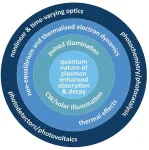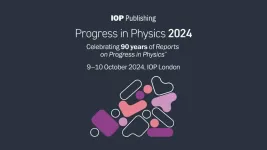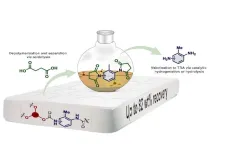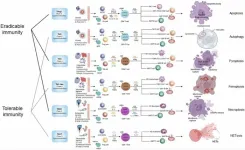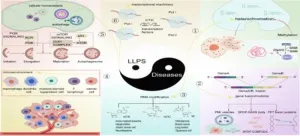(Press-News.org) The European Union's law on artificial intelligence came into force on 1 August. The new AI Act essentially regulates what artificial intelligence can and cannot do in the EU. A team led by computer science professor Holger Hermanns from Saarland University and law professor Anne Lauber-Rönsberg from Dresden University of Technology has examined how the new legislation impacts the practical work of programmers. The results of their analysis will be published in the autumn.
'The AI Act shows that politicians have understood that AI can potentially pose a danger, especially when it impacts sensitive or health-related areas,' said Holger Hermanns, professor of computer science at Saarland University. But how does the AI Act affect the work of the programmers who actually create AI software? According to Hermanns, there is one question that almost all programmers are asking about the new law: 'So what do I actually need to know?'. After all, there aren't many programmers with the time or inclination to read the full 144-page regulation from start to finish.
But an answer to this frequently asked question can be found in the research paper 'AI Act for the Working Programmer', which Holger Hermanns has written in collaboration with his doctoral student Sarah Sterz, postdoctoral researcher Hanwei Zhang, professor of law at TU Dresden Anne Lauber-Rönsberg and her research assistant Philip Meinel. Sarah Sterz summarized the main conclusion of the paper as follows: 'On the whole, software developers and AI users won't really notice much of a difference. The provisions of the AI Act only really become relevant when developing high-risk AI systems.'
The European AI Act aims to protect future users of a system from the possibility that an AI could treat them in a discriminatory, harmful or unjust manner. If an AI does not intrude in sensitive areas, it is not subject to the extensive regulations that apply to high-risk systems. Holger Hermanns offered the following concrete example as an illustration of what this means in practice: 'If AI software is created with the aim of screening job applications and potentially filtering out applicants before a human HR professional is involved, then the developers of that software will be subject to the provisions of the AI Act as soon as the program is marketed or becomes operational. However, an AI that simulates the reactions of opponents in a computer game can still be developed and marketed without the app developers having to worry about the AI Act.'
But high-risk systems, which in addition to the applicant tracking software referred to above, also include algorithmic credit rating systems, medical software or programs that manage access to educational institutions such as universities, must conform to a strict set of rules set out in the AI Act now coming into force. 'Firstly, programmers must ensure that the training data is fit for purpose and that the AI trained from it can actually perform its task properly,' explained Holger Hermanns. For example, it is not permissible that a group of applicants is discriminated against because of representational biases in the training data. 'These systems must also keep records (logs) so that it is possible to reconstruct which events occurred at what time, similar to the black box recorders fitted in planes,' said Sarah Sterz. The AI Act also requires software providers to document how the system functions – as in a conventional user manual. The provider must also make all information available to the deployer so that the system can properly be overseen during its use in order to detect and correct errors. (Researchers have recently discussed the search for effective 'human oversight' strategies in another paper.)
Holger Hermanns summarized the impact of the AI Act in the following way: 'The AI Act introduces a number of very significant constraints, but most software applications will barely be affected.' Things that are already illegal today, such as the use of facial recognition algorithms for interpreting emotions, will remain prohibited. Non-contentious AI systems such as those used in video games or in spam filters will be hardly impacted by the AI Act. And the high-risk systems mentioned above will only be subject to legislative regulation when they enter the market or become operational,' added Sarah Sterz. There will continue to be no restrictions on research and development, in either the public or private spheres.
'I see little risk of Europe being left behind by international developments as a result of the AI Act,' said Hermanns. In fact, Hermanns and his colleagues take an overall favourable view of the AI Act – the first piece of legislation that provides a legal framework for the use of artificial intelligence across an entire continent. 'The Act is an attempt to regulate AI in a reasonable and fair way, and we believe it has been successful.'
Original publication
Preprint, the paper will appear in AISoLA 2024, Springer LNCS:
Hermanns, H., Lauber-Rönsberg, A., Meinel, P., Sterz, S., Zhang, H. (2024). AI Act for the Working Programmer: https://doi.org/10.48550/arXiv.2408.01449
Questions can be addressed to:
Prof. Dr. Holger Hermanns
Tel.: +49 681 302-5630
Email: hermanns@cs.uni-saarland.de
Sarah Sterz
Tel.: +49 681 302-5589
Email: sterz@depend.uni-saarland.de
END
What does the EU's recent AI Act mean in practice?
2024-08-16
ELSE PRESS RELEASES FROM THIS DATE:
A visionary approach: How an Argonne team developed accessible maps for colorblind scientists
2024-08-16
Imagine having to do your job, but not being able to visually process the data right in front of you. Nearly eight percent of genetic males and half a percent of genetic females have some form of Color Vision Deficiency (CVD), or the decreased ability to discern between particular colors. CVD is commonly referred to as color blindness.
Scientists use colors to convey information. Many scientists in the weather radar community have CVD and the use and interpretation of color is an important aspect of their work. Most colormaps ...
Unveiling the power of hot carriers in plasmonic nanostructures
2024-08-16
A new scientific review explores the exciting potential of hot carriers, energetic electrons generated by light in plasmonic nanostructures. These tiny structures hold immense promise for future technologies due to their unique way of interacting with light and creating hot carriers.
Hot carriers are electrons with a surplus of energy. When light strikes a plasmonic nanostructure, it can excite these electrons, pushing them out of equilibrium. This non-equilibrium state unlocks a range of fascinating phenomena. Hot carriers can be used to control light itself, potentially leading to ...
New research shows agricultural impacts on soil microbiome and fungal communities
2024-08-16
New research from Smithsonian’s Bird Friendly Coffee program highlights a type of biodiversity that often gets overlooked: soil bacteria and fungal communities. For over twenty years, Smithsonian research has shown that coffee farms with shade trees protect more biodiversity than intensified, monoculture coffee farms. The new research, published today in Applied Soil Ecology, shows that soil bacteria and fungi on coffee farms also respond to the intensity of coffee farm management. To conduct this research, the team collected soils samples on coffee farms in Colombia, El Salvador, and Peru and used DNA analysis to profile bacterial and fungal soil on ...
Tracking down the asteroid that sealed the fate of the dinosaurs
2024-08-16
Geoscientists from the University of Cologne have led an international study to determine the origin of the huge piece of rock that hit the Earth around 66 million years ago and permanently changed the climate. The scientists analysed samples of the rock layer that marks the boundary between the Cretaceous and Paleogene periods. This period also saw the last major mass extinction event on Earth, in which around 70 percent of all animal species became extinct. The results of the study published in Science indicate that the asteroid formed outside Jupiter’s orbit during the ...
IOP Publishing hosts Progress In Physics 2024 – a two-day hybrid conference focused on condensed matter physics
2024-08-16
The Institute of Physics and IOP Publishing (IOPP) are launching Progress In Physics 2024, a two-day hybrid workshop hosted at the Institute of Physics’ office in London from 9-10 October 2024. The event will cover topics on condensed matter and will bring together leading physics researchers to exchange knowledge in both an in-person and online format.
Progress in Physics 2024 aligns with the mission of IOPP’s new Progress In seriesTM of journals. The series builds on the success of IOPP’s flagship journal Reports on Progress in PhysicsTM which celebrates its 90th anniversary this year.
With ...
Researchers discover smarter way to recycle polyurethane
2024-08-16
Researchers discover smarter way to recycle polyurethane
Researchers at Aarhus University have found a better method to recycle polyurethane foam from items like mattresses. This is great news for the budding industry that aims to chemically recover the original components of the material – making their products cheaper and better.
Polyurethane (PUR) is an indispensable plastic material used in mattresses, insulation in refrigerators and buildings, shoes, cars, airplanes, wind turbine blades, cables, and much more. It could be called a wonder material if it weren’t also an environmental ...
Right on schedule: Physicists use modeling to forecast a black hole's feeding patterns with precision
2024-08-16
Powerful telescopes like NASA’s Hubble, James Webb, and Chandra X-ray Observatory provide scientists a window into deep space to probe the physics of black holes. While one might wonder how you can “see” a black hole, which famously absorbs all light, this is made possible by tidal disruption events (TDEs) - where a star is destroyed by a supermassive black hole and can fuel a “luminous accretion flare.” With luminosities thousands of billions of times brighter than the Sun, accretion events enable astrophysicists to study supermassive black holes (SMBHs) at cosmological distances.
TDEs occur when a star is violently ripped ...
Cell death types and their relations to host immune pathways
2024-08-16
“We have proposed a framework encompassing all discovered host immunological pathways, such as TH1, TH2a, TH2b, TH3, TH9, TH17, TH22, TH1-like, and THαβ immune reactions”
BUFFALO, NY- August 16, 2024 – A new review was published as the cover paper of Aging (listed by MEDLINE/PubMed as "Aging (Albany NY)" and "Aging-US" by Web of Science), Volume 16, Issue 15, entitled, “Types of cell death and their relations to host immunological pathways”.
Various ...
Perceived parental distraction by technology and mental health among emerging adolescents
2024-08-16
About The Study: In a cohort study of 1,300 emerging adolescents ages 9 to 11 across three assessments, higher levels of anxiety symptoms were associated with higher levels of perceived parental technoference later in development. Higher levels of perceived parental technoference were associated with higher levels of inattention and hyperactivity symptoms later in development. The findings of this study speak to the need to discuss digital technology use and mental health with parents and emerging adolescents as a part of routine care.
Corresponding Author: To contact ...
Liquid-liquid phase separation in diseases
2024-08-16
This paper, led by Professor Wu (Wenzhou Institute University, Wenzhou Medical University) and Professor Huang (Northeastern University), explores LLPS, a phenomenon closely associated with various diseases, including cancer and neurodegenerative disorders. As a frontier research area, LLPS plays a significant role in cancer through its regulation of multiple facets, including signaling pathways, gene expression, and tumor microenvironment. Dysregulation of LLPS leads to the formation of various aggregates, such as amyloid proteins, suggesting that modulating LLPS in ...


